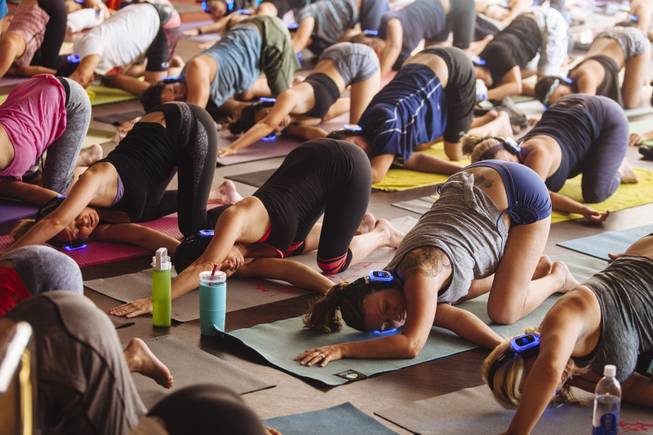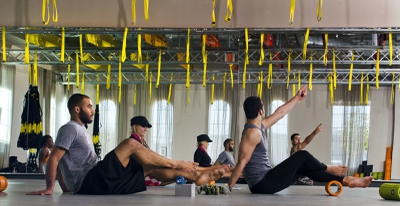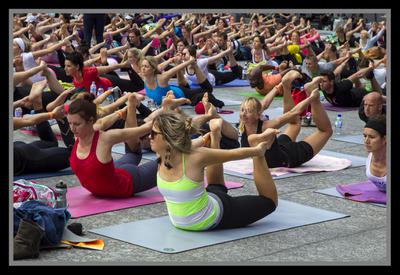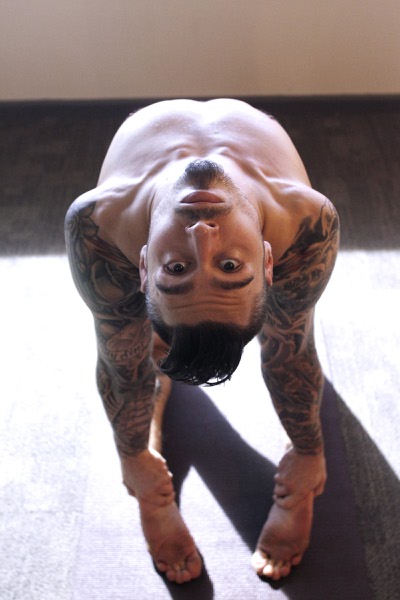
Guests participate in a Silent Savasana session at Red Rock Resort on Sunday, Aug. 16, 2015.
Monday, April 18, 2016 | 2 a.m.
Anywhere from 21 million to 24 million Americans do some form of yoga, according to recent studies from the National Institutes of Health and the Sports and Fitness Industry Association.
That’s a lot of sun salutations and downward dogs.
Gaining popularity in the West
It’s believed that yoga first made an appearance in the U.S. in 1893 when a wandering monk, Swami Vivekananda, spoke at the Parliament of Religions in Chicago, and talked about its health benefis. Yoga has steadily grown over the years, especially over the last few decades as studies revealed the benefits of being a frequent yogi.
If you don’t know what those terms mean, here’s a guide to the art of yoga and a look at why people in Las Vegas are taking out their mats and giving it a try. If you’ve already joined the yoga crowd, read on for info about new variations of the exercise and some of the best places to do it in Las Vegas.
What is yoga?
Mantras (language you might hear in a yoga class)
Mantras are sounds, words or phrases that help focus and uplift. Creating your own mantra or affirmation that brings you peace and guidance is easy and can be tailored to your emotional needs.
“Om:” The Sanskrit word for “original vibration of manifestation,” Om helps you focus and relax.
“I am …:” Fill in the blank and repeat to yourself. “I am present, I am light, I am strong.”
“Love:” Repeating single words and focusing on their personal meaning heightens focus.
Yoga started in India 5,000 years ago and comes from the Sanskrit work “yuj,” meaning “to unite or integrate.” It started as a way to link the body to the mind, harmonizing the two through poses, breathing exercises and meditation. Linking the mind and body has multiple benefits, mainly helping reduce stress and increase relaxation. Sitting still, focusing on your mental state, breathing, adjusting through difficult poses and forcing the mind to concentrate on the present are all critical parts of creating a successful yoga experience.
Nine reasons yoga is good for you
According to a Harvard Medical School study, the body has a “relaxation response” — a state of deep rest that is the physiologic opposite of the flight-or-fight response — to stress, and yoga is a great way to activate it. During the study, students who practiced yoga for 15 minutes a day for eight weeks showed biochemical changes in their brains. Specifically, yoga boosted their level of gamma-aminobutyric acid, or GABA, a neurotransmitter that inhibits the brain from acting on signals from the senses and, by tuning down all of that input, produces a sense of happiness and serenity.
And the GABA boost doesn’t happen just because yoga is exercise; doing push-ups wouldn’t create the same benefits, according to research by the University of Utah and Boston University. Yoga also can produce feelings of security and comfort by aiding the parasympathetic nervous system, which helps control our unconscious functions and whose sole function is to stabilize the body through rest, relaxation and rejuvenation. Yoga reduces the amount of perceived stress, which helps the body perform its functions to keep us alive long-term, like regulating blood pressure, sugar levels and hormone levels.
1. Strengthens body, posture, balance and body alignment
2. Boosts energy
3. Improves respiration and cardio health
Did you know?
In a Harvard Medical School study, those who practiced yoga for eight weeks had better quality of sleep.
4. Improves brain function
5. Balances the endocrine system and hormonal health
6. Anxiety relief
7. Drains your lymph nodes and boosts immunity
8. Increases blood flow
9. Improves self-awareness
Yoga increases strength and awareness in the body and mind. During yoga classes, instructors often ask participants to “check in” with their bodies, or listen to what their bodies are telling them. The repetition of asking yourself what your body is doing and needs creates a greater self-awareness. In addition, yoga has been proved to help people relax their mind, center their concentration and relieve chronic stress problems by helping the body regulate the hormone cortisol, which is released in response to stress.
What kind of equipment do I need?
Yoga is pretty simple: barefoot is best and comfortable, stretchy clothing is necessary. The main investment when practicing yoga is the mat. Before going to a studio, call and see if it has complimentary mats for class use. If not, there are a few things to consider before buying:
Length: If you are particularly tall or just prefer more surface space, check a mat’s measurements before buying.
Thickness: Depending on your body’s sensitivity or injuries, a thicker mat works best for extra cushion and support.
Traction: Transitioning from pose to pose is difficult on a slippery mat. Check for grip and absorption.
Odor: Rubber mats will have an odor, while PVC mats will not. PVC is usually a little more expensive but worth it for a zero-stink risk.
Breathing is the foundation of proper practice
Regardless of what type of yoga you practice, the mere act of yoga hinges on the connection to your breath.
Pranayama is a Sanskrit term that means “control of breath;” however, the principle of prana extends far beyond control itself, evoking breath as the life source and vital energy of the body. Pranayama works as the glue that connects the mind, the body and the spirit during yoga.
Yogis have revered pranayama for thousands of years, claiming that it keeps the mind calm while energizing the body and spirit.
The idea is: As you breath steadily, the air flows through each of your chakras, or energy points, which invigorates, spreads positivity and unifies the body.
Throughout any practice, being aware of your breath and maintaining a steady breathing cycle is necessary. Your breath should never feel labored (even in difficult poses), should never be lost (even in resting poses) and should flow in synchronicity with each changing pose. Of all the many mantras and sayings that are repeated throughout yoga classes across the globe, “just breathe through it” may be at the top of the list.
Different types of yoga may also encourage different breathing exercises, such as ujjayi breathing, breath retention, sealing breaths and single-nostril breathing.
— Emma Cauthorn
The importance of mindfulness and meditation
Yoga is not just about moving from pose to pose, but also allowing your mind to stretch, flow and concentrate. The idea behind being mindful during a practice is to understand your body and focus deeply. Yoga is a balanced practice of physical and mental flexibility. In order to move into postures, being present is necessary. Some yoga instructors will have students focus on their breath, a specific part of the body, a chakra (large, concentrated pools of energy) or a mantra. When focusing on any one of these, stresses and insecurities get pushed to the back of the mat. If you are starting yoga on your own at a new studio or at home, you can access your inner yogi by knowing common chakras and mantras.
What is a chakra?
In Sanskrit, chakra translates to wheel or disk. It is an Indian belief that chakras are the wheels of energy throughout the body. The seven main chakras contain bundles of nerves and are linked to an organ and an emotional state of being. For yogis, being constantly aware of the openness and fluidity of these chakras helps with physical and emotional ailments.
The ancient belief behind chakras is that our body tells us what our emotional troubles are by presenting physical discomfort through different parts of our body. Stomach pains may represent problems with self-esteem and nervousness, while throat pain may represent a feeling of not being able to speak honestly or issues in communication.
Crown Chakra: This is the highest chakra located at the top of the head, and connected to spiritual bliss.
Third Eye Chakra: Located between the eyes, the third eye helps you see the big picture and focus.
Throat Chakra: Aiding in our ability to communicate, the throat chakra helps express truth.
Heart Chakra: Representing our ability to love and find inner peace, the heart chakra is in the center of the chest.
Solar Plexus Chakra: Find this chakra in your upper abdomen. It is tied to feelings of self-worth, confidence and self-esteem.
Sacral Chakra: This chakra aids in our connection with new people and experiences, and is in the lower abdomen about 2 inches below the navel and inward.
Root Chakra: Located at the base of your spine, this chakra represents foundation.
Types of yoga
Hatha: Ideal for beginners, this type of yoga helps develop balance, flexibility and breath. It is considered a relaxing and restorative class.
Restorative: This version of yoga is said to be more rejuvenating than a nap, is typically done at night and can also be called “candlelight yoga.”
Vinyasa: Classes are fairly fast paced and have a fluid style to them. All poses transition easily together, and no two classes are the same.
Bikram: Classes are in an artificially heated room, typically at 104 degrees, with 40 percent humidity, and take you through a sequence of 26 poses.
Ashtanga: More rigorous than many styles of yoga, this practice is physically demanding, making it perfect for strength and endurance building.
Kundalini: Physical movement is combined with chanting and breathing to calm the mind and body. It is considered one of the more “out there” practices.
Iyengar: This type of yoga is fantastic for individuals with chronic pain. It focuses on proper alignment, balance and strength.
Doga: Created in New York, Doga is a new form of yoga for your furry friends. Pups can lightly stretch with their owner’s help and be used as props for their owners.
Brew-ga: Sometimes known as as Brewsana, sip on a pint while you slip into poses. No real health benefits to this one but nonetheless, dozens of breweries over the country are pairing with yogis to teach and drink.
Topless: Yoga studios in Los Angeles started a class where women can drop their insecurities and their sport bras.
Snow-ga: Cities with snowy winters can now look out for snow-ga. Teachers encourage students to bundle up and get stretching. If you want a good laugh, get on your social media accounts and look up #snowga.
Yoga among the dolphins: Only in Las Vegas can you wake up early and settle into tree pose with a view of the dolphins at the Mirage. Participants are escorted to a private room within the dolphin habitat with multiple windows and prime dolphin-viewing space. Classes are at 8:30 a.m. Friday through Sunday. Each 60-minute class session is $50, including a postclass smoothie, use of a yoga mat and a day pass for the fitness center, spa vanity and lockers.
Where can I practice in Las Vegas?
Before you put down money on a new studio membership, check with your gym to see if yoga classes are part of your membership. Multiple gyms around the valley including Eos, Lifetime, Las Vegas Athletic Club, 24 Hour Fitness (and more) offer yoga classes during the week. If you are interested in getting a membership at a yoga studio in the valley, here’s where fellow yoga-lovers are raving about:
Silent Savasana
Pop-up sites are announced on social media
Yoga with a twist, Silent Savasana holds pop-up events around the city and utilizes headphones to connect participants with instructors and music. Find them on Facebook or visit silentsavasana.com for updates.
Trufusion
8575 S. Eastern Ave.
With more than 200 classes a week, you’ll find a style you love at this studio. It’s grown so much, more locations are opening soon.
Sherry Goldstein’s Yoga Sanctuary
7915 W. Sahara Ave.
Yoga classes are offered every day of the week here, and the first class is free for locals. Want to try more classes? Locals pay $12 for drop-in classes.
Barefoot Sanctuary
6689 Las Vegas Blvd. South
Tucked inside Whole Foods Market at Town Square, Barefoot Sanctuary offers belly dancing, handstand and yoga classes. Newcomers can try unlimited classes for 30 days for $39.
Bikram Yoga Las Vegas
5031 Wagon Trail Ave., Suite 107
If you are up for the challenge of a 90-minute yoga session in over 100 degree artificial heat, then this is your studio. A trial run of 14 consecutive days is $30 for locals.
Modo Yoga
3638 E. Sunset Road, Suite 110
Offering classes every day of the week, this studio is great for beginners and advanced yogis alike. The introductory rate is 30 days for $40.
The Grateful Yogi
8550 W. Charleston Blvd.
This studio is focused on a kirtan yoga, creativity and community. A month of unlimited classes costs $108, with single classes at $18. Discounts for military, teachers and students are available.




Join the Discussion:
Check this out for a full explanation of our conversion to the LiveFyre commenting system and instructions on how to sign up for an account.
Full comments policy